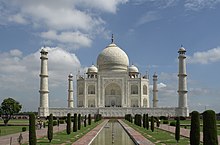


Mughal architecture is the type of Indo-Islamic architecture developed by the Mughals in the 16th, 17th and 18th centuries throughout the ever-changing extent of their empire in the Indian subcontinent. It developed from the architectural styles of earlier Muslim dynasties in India and from Iranian and Central Asian architectural traditions, particularly Timurid architecture.[3][4][5][6][7] It also further incorporated and syncretized influences from wider Indian architecture, especially during the reign of Akbar (r. 1556–1605).[3][4][6][7] Mughal buildings have a uniform pattern of structure and character, including large bulbous domes, slender minarets at the corners, massive halls, large vaulted gateways, and delicate ornamentation; examples of the style can be found in modern-day Afghanistan, Bangladesh, India and Pakistan.
The Mughal dynasty was established after the victory of Babur at Panipat in 1526. During his five-year reign, Babur took considerable interest in erecting buildings, though few have survived. His grandson Akbar built widely, and the style developed vigorously during his reign. Among his accomplishments were Agra Fort, the fort-city of Fatehpur Sikri, and the Buland Darwaza. Akbar's son Jahangir commissioned the Shalimar Gardens in Kashmir.
Mughal architecture reached its zenith during the reign of Shah Jahan, who constructed Taj Mahal, the Jama Masjid of Delhi, the Shalimar Gardens of Lahore, and renovated the Lahore Fort. High-ranking officials below the emperor were also able to build major monuments, as with the example of the Wazir Khan Mosque. The last of the great Mughal patrons was Aurangzeb, who built the Badshahi Mosque, Bibi Ka Maqbara, Moti Masjid etc.
- ^ "Taj Mahal World Heritage". UNESCO World Heritage. Centre. Archived from the original on 1 February 2018. Retrieved 31 December 2018.
- ^ Meri, Josef W., ed. (2005). Medieval Islamic Civilization: An Encyclopedia. Routledge. p. 91. ISBN 978-1-135-45596-5.
- ^ a b Asher 1992, pp. 1–2.
- ^ a b Petersen, Andrew (1996). "Mughals". Dictionary of Islamic architecture. Routledge. pp. 199–205. ISBN 9781134613663.
- ^ Bloom & Blair 2009, Architecture; VII. c. 1500–c. 1900; D. India.
- ^ a b Vaughan, Philippa (2011). "Indian Subcontinent: from Sultanate to Mughal Empire". In Hattstein, Markus; Delius, Peter (eds.). Islam: Art and Architecture. h.f.ullmann. pp. 464–483. ISBN 9783848003808.
- ^ a b Asher, Catherine B. (2020). "Mughal architecture". In Fleet, Kate; Krämer, Gudrun; Matringe, Denis; Nawas, John; Rowson, Everett (eds.). Encyclopaedia of Islam, Three. Brill. ISSN 1873-9830.